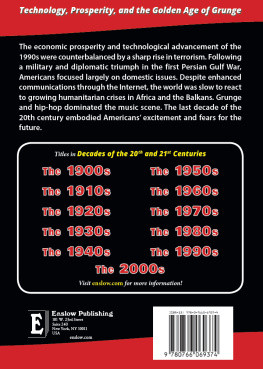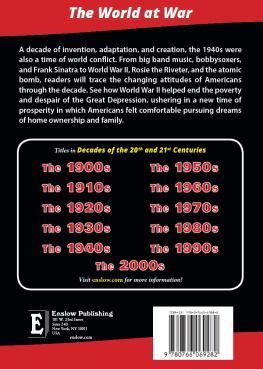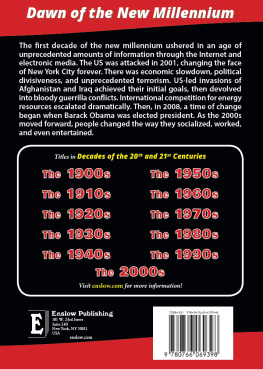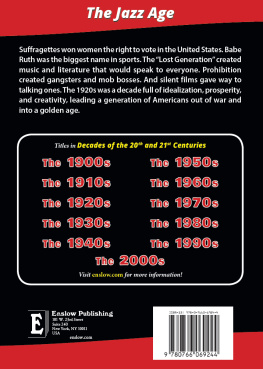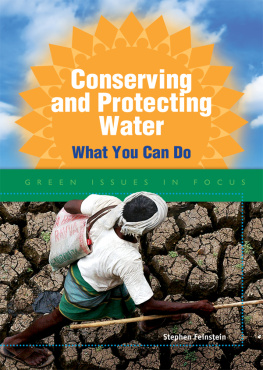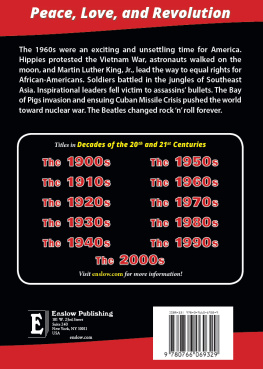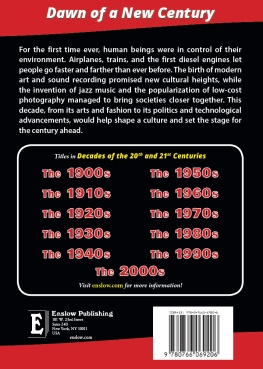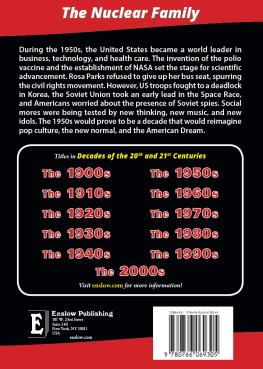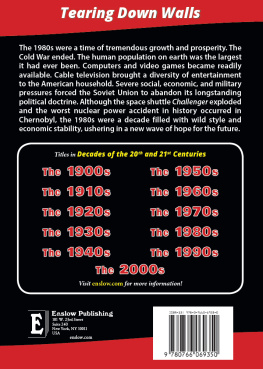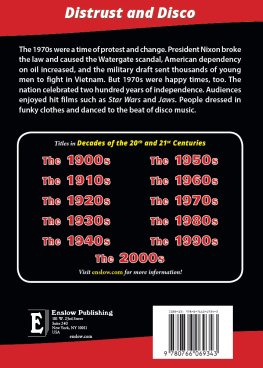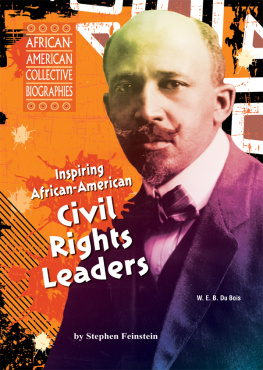Stephen Feinstein - The 1910s
Here you can read online Stephen Feinstein - The 1910s full text of the book (entire story) in english for free. Download pdf and epub, get meaning, cover and reviews about this ebook. publisher: Enslow Publishing, genre: History. Description of the work, (preface) as well as reviews are available. Best literature library LitArk.com created for fans of good reading and offers a wide selection of genres:
Romance novel
Science fiction
Adventure
Detective
Science
History
Home and family
Prose
Art
Politics
Computer
Non-fiction
Religion
Business
Children
Humor
Choose a favorite category and find really read worthwhile books. Enjoy immersion in the world of imagination, feel the emotions of the characters or learn something new for yourself, make an fascinating discovery.
- Book:The 1910s
- Author:
- Publisher:Enslow Publishing
- Genre:
- Rating:4 / 5
- Favourites:Add to favourites
- Your mark:
- 80
- 1
- 2
- 3
- 4
- 5
The 1910s: summary, description and annotation
We offer to read an annotation, description, summary or preface (depends on what the author of the book "The 1910s" wrote himself). If you haven't found the necessary information about the book — write in the comments, we will try to find it.
The 1910s — read online for free the complete book (whole text) full work
Below is the text of the book, divided by pages. System saving the place of the last page read, allows you to conveniently read the book "The 1910s" online for free, without having to search again every time where you left off. Put a bookmark, and you can go to the page where you finished reading at any time.
Font size:
Interval:
Bookmark:


Published in 2016 by Enslow Publishing, LLC.
101 W. 23rd Street, Suite 240, New York, NY 10011
Copyright 2016 by Enslow Publishing, LLC.
All rights reserved.
No part of this book may be reproduced by any means without the written permission of the publisher.
Library of Congress Cataloging-in-Publication Data
Feinstein, Stephen.
The 1910s / Stephen Feinstein.
pages cm. (Decades of the 20th and 21st centuries)
Summary: Discusses the decade 1910-1919 in the United States in terms of culture, art, science, and politicsProvided by publisher.
Audience: Grade 9 to 12.
ISBN 978-0-7660-6922-0
1. United StatesCivilization1865-1918Juvenile literature. 2. United StatesPolitics and government1913-1921Juvenile literature. 3. United StatesPolitics and government1909-1913Juvenile literature. 4. Nineteen tensJuvenile literature. I. Title.
E169.1.F3539 2015
973.912dc23
2015010943
Printed in the United States of America
To Our Readers: We have done our best to make sure all Web sites in this book were active and appropriate when we went to press. However, the author and the publisher have no control over and assume no liability for the material available on those Web sites or on any Web sites they may link to. Any comments or suggestions can be sent by e-mail to .
Photo Credits: Ann Ronan Pictures/Print Collector/Getty Images, pp. (top).
Cover Credits: DEA Picture Library/De Agostini Picture Library/Getty Images (Titanic); Everett Historical/Shutterstock.com (child labor); Fotosearch/Getty Images (suffragettes); Hulton Archive/Getty Images (Louis Armstrong).
Contents
Introduction
Pop Culture, Lifestyles, and Fashion
Entertainment and the Arts
Sports
National and International Politics
Advances in Science, Technology, and Medicine
Conclusion
Timeline
Glossary
Further Reading
Index

The unsinkable Titanic hit an iceberg, sank, and killed more than 1,500.
Introduction
Progress does not mean the end of problemsthat was the lesson of the 1910s. During the first decade of the twentieth century, Americans had made great gains. They saw many advances in science and technology, and they lived in the richest nation in the world. This progress would continue during the 1910s. However, there would also be many terrible disasters during this decade that would slow societys zeal for rapid growth. By the end of the decade, many people longed for a simpler time.
Some of the disasters during the 1910s showed that science and technology did not hold all of the answers. One example was the sinking of the supposedly unsinkable Titanic in April 1912. Later in the decade, a deadly flu epidemic spread across the globe. All the advances of modern medicine could not stop a tiny virus from causing an illness that killed millions of people.
Science and technology were not always applied in peaceful or benevolent ways, either. New factories created modern weapons that made it easier to kill. In August 1914, these terrifying weapons were unleashed and used by millions of soldiers in World War I. This war was the worst tragedy of the 1910s. It killed ten million people.
At first, Americans felt the war was strictly a matter involving European countries. But when German submarine attacks claimed American victims, the president sent American soldiers into the war to fight on the side of Great Britain, France, and other countries known as the Allies. Their enemies were Germany, Austria-Hungary, and their allies, which were called the Central Powers.
As American soldiers fought overseas, the Bolshevik Revolution occurred in Russia. Vladimir Lenin became the ruler of the worlds first communist nation. Many Americans began to fear that a communist revolution could happen in America. In 1919, a Red Scare (communists were often called Reds) swept the nation. Also that year, the worst race riot of the decade occurred in Chicago.
America helped the Allies win the war, but US president Woodrow Wilson could not convince them to agree to a fair peace treaty. To punish the Central Powers for starting the war, the Allies enforced crippling fines and took land from Germany and its allies to build up their own empires. This caused deep bitterness in the people of the defeated nations. Without realizing it, the treatys authors had sown the seeds for another world war.
American soldiers returned from the battlefield to find that important changes were taking place at home. Throughout the 1910s, women tried to earn the right to vote. Americans approved the Seventeenth Amendment to the US Constitution, which allowed senators to be elected by the people. This was considered a major progressive accomplishment. Many immigrants arrived from other countries and hoped to become US citizens. A young film industry took root in Hollywood, California. By the end of 1919, Americans did not want to hear any more about wars or bad news from overseas. After a decade of disasters, Americans were ready to have some fun.
Pop Culture, Lifestyles, and Fashion
By 1910, America had become the richest nation in the world. As such, it acted as a magnet and drew millions of people from around the world seeking a better life for their families.
Immigrants Arrive in Record Numbers
As if in response to the invitation engraved on the Statue of Liberty Give me your tired, your poor, your huddled masses yearning to breathe freemillions of immigrants arrived at Ellis Island in New York Harbor to begin a new life in America. Many were fleeing religious, racial, or political persecution. Most hoped to escape a life of dire poverty. For the millions willing to endure the hardships of immigration, America was indeed a promised land. In 1910, the massive wave of immigration that had begun in 1890 was at its height. That year, more than one million immigrants, primarily Jews, Slavs, and Italians from eastern and southern Europe, entered the United States. Most settled in the large cities of the Northeast and Midwest, where factories needed workers. Immigrants from Asia, most of them Chinese, arrived on the West Coast at Angel Island in San Francisco Bay.
By the middle of the decade, many native-born Americans were becoming alarmed at the huge influx of newcomers. Recent immigrants spoke foreign languages and had different religions, customs, cultural values, and political views. Assimilation into American society was a slow and difficult process for many immigrants. Anti-immigrant feelings began to grow.

Immigrants flocked to America in search of opportunity.
Responding to this pressure, Americanization programs were established in schools around the country. Adult immigrants were taught English, as well as courses in American cooking, housekeeping, and childcare. The government also passed the Immigration Act of 1917. This law imposed a literacy test for immigrants. It also prohibited Asian laborers from entering the country, except for those from nations that had special trade agreements with the United States. Immigration did, in fact, drop sharply during the years of World War I because of wartime restrictions and the difficulties of traveling during a war, and the new law caused a further decrease. Even so, by 1920 more than eighteen million immigrants had come to America during the thirty-year period beginning in 1890.
Font size:
Interval:
Bookmark:
Similar books «The 1910s»
Look at similar books to The 1910s. We have selected literature similar in name and meaning in the hope of providing readers with more options to find new, interesting, not yet read works.
Discussion, reviews of the book The 1910s and just readers' own opinions. Leave your comments, write what you think about the work, its meaning or the main characters. Specify what exactly you liked and what you didn't like, and why you think so.


